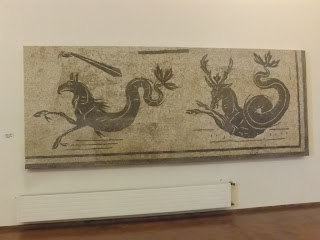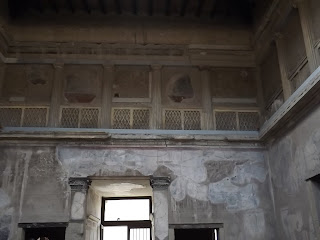Today we had a field trip down south of Rome, to the Naples Archaeological Museum, Herculaneum and the Villa Oplontis.
Our first stop was the Archaeological Museum in Naples. This museum is full of treasures from Herculaneum and Pompeii, towns that were covered by the eruption of Mount Vesuvius in 79 AD.
On hand to greet us as we entered the incredible Farnese Collection of statues was Apollo, with his lyre and wearing a laurel wreath on his head.
Then we saw the Farnese Hercules.
The goddess Flora.
The Lar--Lares were guardian spirits who protected members of a family.
Achilles carrying Troilus.
Minerva.
Isis/Fortuna
Aesclepius--the god of medicine.
Another Minerva.
The famous Farnese Bull. This statue illustrates a scene in Euripedes play Antiope. A woman named Dirce tries to kill Antiope who had two sons after she was raped by Zeus. Antiope convinces the boys she is their mother and they kill Dirce by tying her to the horns of the bull.
Outside of the Farnese statues are many other important works, like this head of Julius Caesar.
and this of the Emperor Vespasian. Vespasian wanted to set a different standard from the excesses of Nero, so all his portrait sculptures are done in the older style of the Roman Republic, showing "warts and all."
The emperor Caracalla. He was much feared and killed his brother. Kind of easy to see.
Another Minerva.
A river god, chillin'
A different river god, also chillin'
A not cowardly lion.
These next four statues are of Danaids dancing. They were retrieved from the peristyle (courtyard) of a house in Herculaneum.
The drunken satyr, also from Herculaneum.
Another satyr from Herculaneum
A picture showing Mount Vesuvius before the eruption of 79 AD. Notice the shape. This will be important to reference later.
A 3D model of the excavation at Pompeii.
A mosaic of chickens.
A shrine mosaic.
A mosaic featured in the opening credits of HBO's Rome miniseries.
A famous mosaic from Pompeii showing Alexander the Great defeating the Persians.
A picture of Mount Vesuvius looming over the excavations of Herculaneum. The cone on the right is the modern cone, but the shoulder on the left was part of Mount Vesuvius before the 79 AD eruption. If you draw the lines of the shoulders up through space, you can see the vast amount of the mountain that was blown up in the eruption.
The next few shots are of Herculaneum. This place always strikes me because these people appreciated beauty and surrounded themselves with lovely things. Their cultural sophistication is not so distant from our own.
A peristyle, or courtyard.
A marble threshold.
Mosaic floor.
Frescoes above a household shrine.
Frescoes.
Marble floor
A mosaic of glass beads.
A tablinum, or shop, with a marble counter. These were the fast food emporiums of the day. Notice the large terra cotta pots under the counter that hold what was sold.
A cross-shaped impluvium.
More frescoes.
These next shots are from the sanctuary of the deified Augustus. Here is the marble floor.
Some ceiling decor.
Mosaic floor
Frescoes.
Outside we see the remnants of a portico
and a basilica (indoor meeting place)
This building was a grain mill.
Here the owner of the house decorated the sidewalk outside with colored marble chips. Some of the marble has been traced back to Turkey. The owner paid some serious money just to decorate his sidewalk to make it look nice, and so that others would know he had the money to do it!
Mosaic floor and frescoed walls.
Original woodwork that survivded being covered by the hot mud that flowed down onto Herculaneum in the eruption. More wood survived in Herculaneum than in Pompeii because they were covered by different types of effluvia from the volcano.
One of my favorite mosaics, of glass beads.
with a fresco bordering.
and another mosaic flanking it.
Marble and mosaic flooring.
The baths at Herculaneum
The fluted ceiling was designed to capture the condensation and return the water to the system.
The peristyle outside the baths
An atrium showing some of the charred, but original, wooden beams.
After Herculaneum, we took a short drive the the Villa Oplontis, also buried in the eruption of 79.
The villa is known for its frescoes.
It also has some beautiful marble floors
and a swimming pool.






























































































